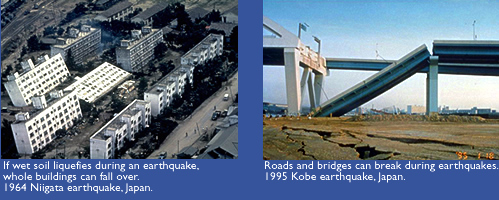Earthquakes are more dangerous
Closer to the focus Communities
that are closer to the focus of an earthquake usually experience
stronger shaking.
Nearer to the surface
Earthquakes that occur near the surface cause more damage
than those deep underground.
As the shaking goes on
The longer the shaking continues, the more damage it causes.
The 2001 Nisqually earthquake lasted about 40 seconds. The
1700 subduction zone earthquake may have lasted five minutes.
On loose ground Loose
materialslandfills and loose sedimentsshake more
than solid bedrock. Geologists compare this to a bowl of jelly.
If its jostled, the bowl itself will shake just a little.
But the jelly keeps on jiggling; it actually amplifies the
motion.
On wet soil If loose soil
is saturated with water, it may flow like a liquid when shaken
in an earthquake. This process is called liquefaction. The
soil loses its strength and no longer supports structures
built upon it.
On slopes During quakes,
slopes may slide. Also, if trees have been cut down, slopes
are more vulnerable to earthquake damage. Slopes composed
of loose backfilled materials may be unstable during quakes.
Near structures If youre in the
middle of a wheat field, youre not likely to be hurt
by an earthquake. Most damageand most injuriesinvolve
human structures. Unreinforced brick walls and chimneys cant
handle the side-to-side shaking of a large earthquake. Falling
bricks are a major cause of injuries. Older concrete structures
also may be unstable. And even a small earthquake may bring
household objects down around your ears. Damage to lifelinesroads
or bridgescan have life-changing impacts on area residents.
Whole communities may be cut off from fire engines, ambulances,
and supplies.
Research for safety
Although we cant prevent earthquakes, engineering researchers
are pioneering safer construction techniques to protect us
from earthquake damage. Homes now are bolted to their foundations,
brick and concrete are specially reinforced, and roads, bridges,
and buildings are built with earthquakes in mind.

|

